University Assignment: Jumbo Seafood Hospitality Operations Management
VerifiedAdded on 2020/04/15
|20
|4402
|329
Report
AI Summary
This report provides a comprehensive analysis of Jumbo Seafood's hospitality operations management. It begins with an overview of Jumbo Seafood, its products, and the influences affecting demand patterns. The report delves into customer profiles, expectations, and spending power, followed by product suggestions to meet target audience needs. It examines the features of suggested products, opportunities, and constraints in product development, and promotional strategies. Furthermore, the report discusses various pricing methods, factors impacting food and beverage profitability, performance measures, and approaches to business analysis and evaluation within the hospitality context. The assignment offers valuable insights into the operational aspects of a successful restaurant business, emphasizing customer satisfaction, product innovation, and strategic management.
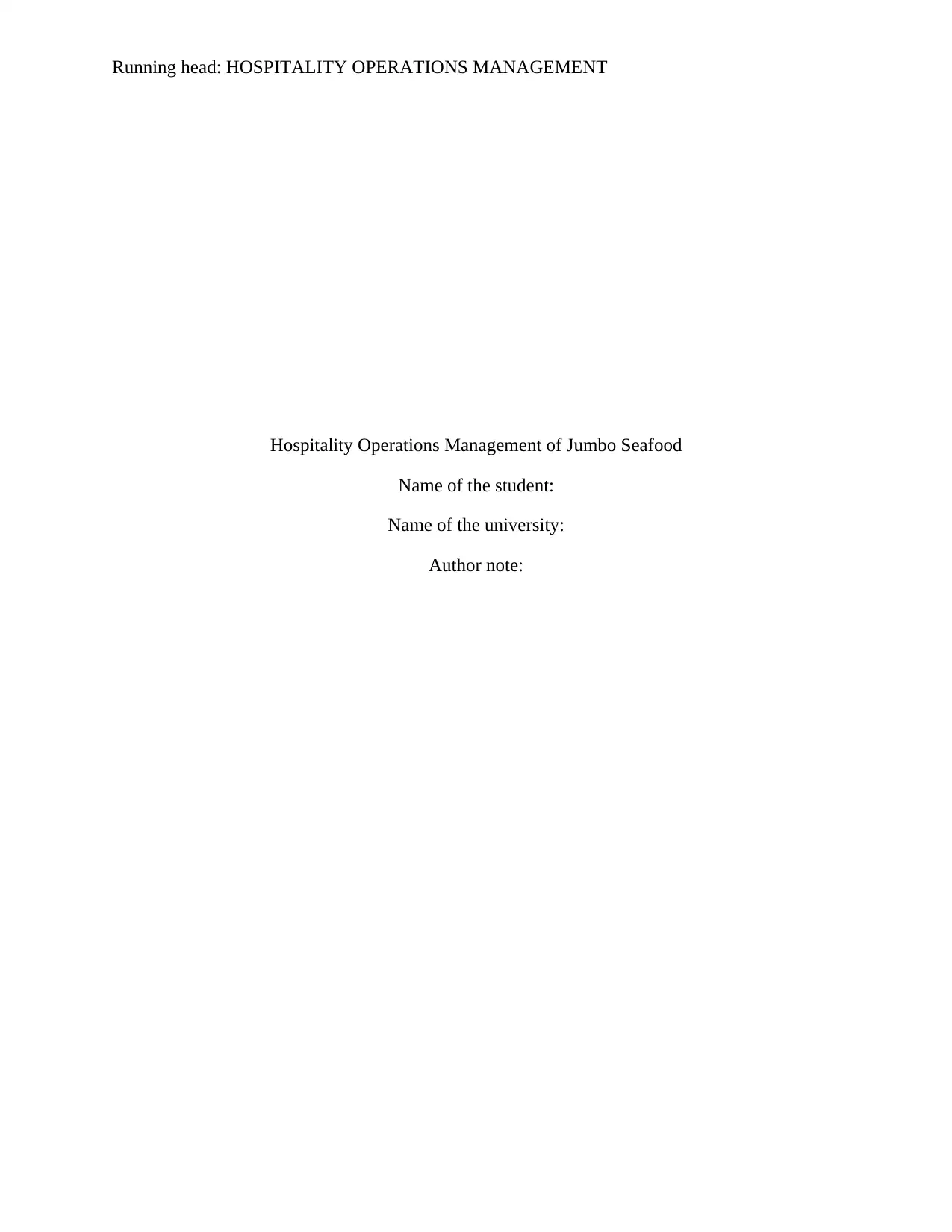
Running head: HOSPITALITY OPERATIONS MANAGEMENT
Hospitality Operations Management of Jumbo Seafood
Name of the student:
Name of the university:
Author note:
Hospitality Operations Management of Jumbo Seafood
Name of the student:
Name of the university:
Author note:
Paraphrase This Document
Need a fresh take? Get an instant paraphrase of this document with our AI Paraphraser
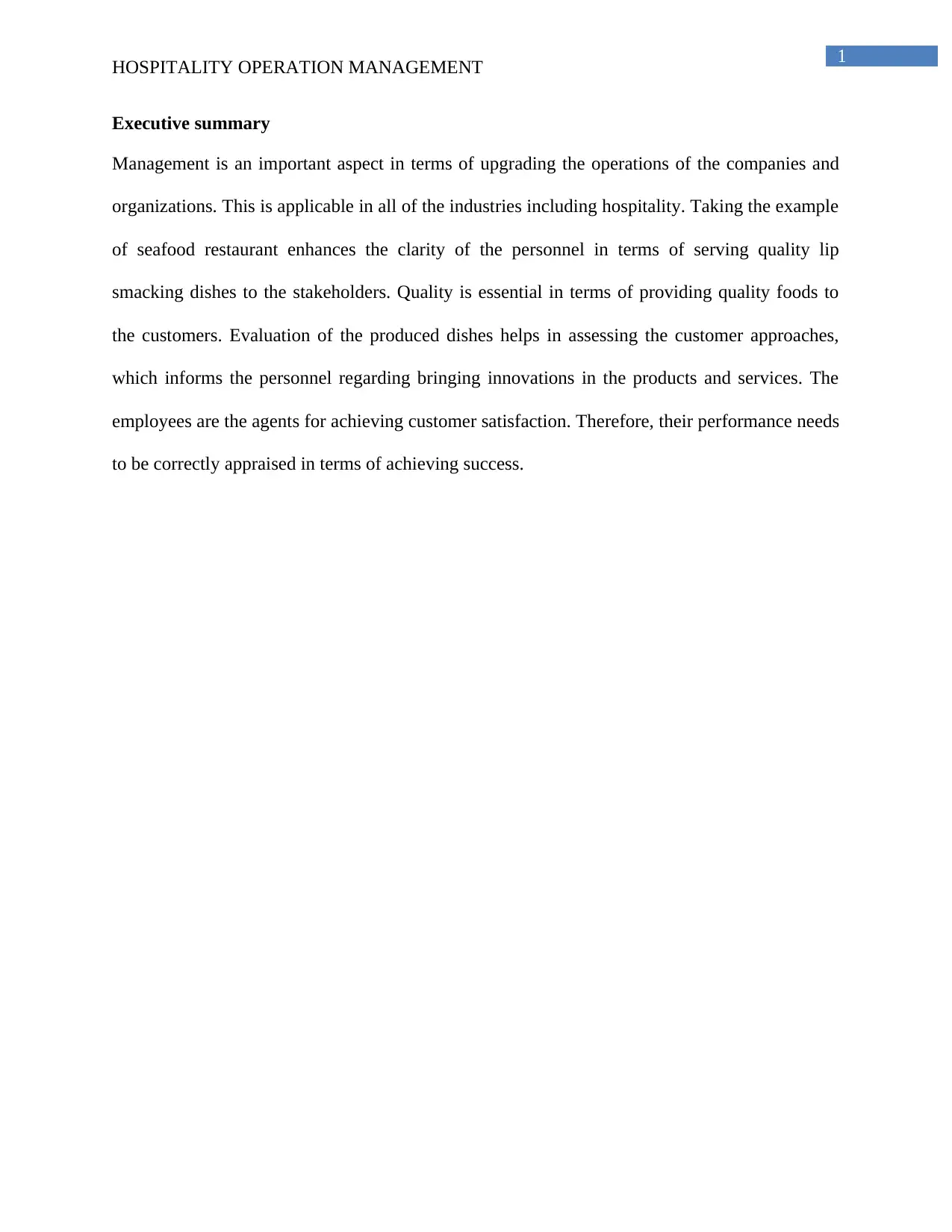
1
HOSPITALITY OPERATION MANAGEMENT
Executive summary
Management is an important aspect in terms of upgrading the operations of the companies and
organizations. This is applicable in all of the industries including hospitality. Taking the example
of seafood restaurant enhances the clarity of the personnel in terms of serving quality lip
smacking dishes to the stakeholders. Quality is essential in terms of providing quality foods to
the customers. Evaluation of the produced dishes helps in assessing the customer approaches,
which informs the personnel regarding bringing innovations in the products and services. The
employees are the agents for achieving customer satisfaction. Therefore, their performance needs
to be correctly appraised in terms of achieving success.
HOSPITALITY OPERATION MANAGEMENT
Executive summary
Management is an important aspect in terms of upgrading the operations of the companies and
organizations. This is applicable in all of the industries including hospitality. Taking the example
of seafood restaurant enhances the clarity of the personnel in terms of serving quality lip
smacking dishes to the stakeholders. Quality is essential in terms of providing quality foods to
the customers. Evaluation of the produced dishes helps in assessing the customer approaches,
which informs the personnel regarding bringing innovations in the products and services. The
employees are the agents for achieving customer satisfaction. Therefore, their performance needs
to be correctly appraised in terms of achieving success.

2
HOSPITALITY OPERATION MANAGEMENT
Table of contents
Introduction......................................................................................................................................3
Task 1...............................................................................................................................................3
1.1 An insight into Jumbo Seafood and their product.....................................................................3
1.2 Different influences affecting patterns of demand of products and service..............................4
1.3 Customer and guest profiles and comparison of their expectations and requirements towards
the products and services.................................................................................................................5
1.4 Different factors affecting the average spending power............................................................6
Task 2...............................................................................................................................................7
2.1 Suggestion of products for catering to the needs of the target audience...................................7
2.2 Analysis of the features of the suggested product in terms of the customer perceptions..........8
2.3 Opportunities and constraints affecting the product and service development.........................8
2.4. Promotions or Packages for Strengthening Merchandising......................................................9
Task 3.............................................................................................................................................11
3.1. Different Methods of Pricing..................................................................................................11
3.2. Food and Beverage Operations Factors Impacting Profitability............................................11
Task 4.............................................................................................................................................13
4.1 Performance measures related to hospitality operations.........................................................13
4.2. Effectiveness of Qualitative and Quantitative Appraisals......................................................13
4.3. Approaches to Business Analysis and Evaluation in Hospitality Operations........................14
Conclusion.....................................................................................................................................15
References and bibliography.........................................................................................................17
HOSPITALITY OPERATION MANAGEMENT
Table of contents
Introduction......................................................................................................................................3
Task 1...............................................................................................................................................3
1.1 An insight into Jumbo Seafood and their product.....................................................................3
1.2 Different influences affecting patterns of demand of products and service..............................4
1.3 Customer and guest profiles and comparison of their expectations and requirements towards
the products and services.................................................................................................................5
1.4 Different factors affecting the average spending power............................................................6
Task 2...............................................................................................................................................7
2.1 Suggestion of products for catering to the needs of the target audience...................................7
2.2 Analysis of the features of the suggested product in terms of the customer perceptions..........8
2.3 Opportunities and constraints affecting the product and service development.........................8
2.4. Promotions or Packages for Strengthening Merchandising......................................................9
Task 3.............................................................................................................................................11
3.1. Different Methods of Pricing..................................................................................................11
3.2. Food and Beverage Operations Factors Impacting Profitability............................................11
Task 4.............................................................................................................................................13
4.1 Performance measures related to hospitality operations.........................................................13
4.2. Effectiveness of Qualitative and Quantitative Appraisals......................................................13
4.3. Approaches to Business Analysis and Evaluation in Hospitality Operations........................14
Conclusion.....................................................................................................................................15
References and bibliography.........................................................................................................17
⊘ This is a preview!⊘
Do you want full access?
Subscribe today to unlock all pages.

Trusted by 1+ million students worldwide
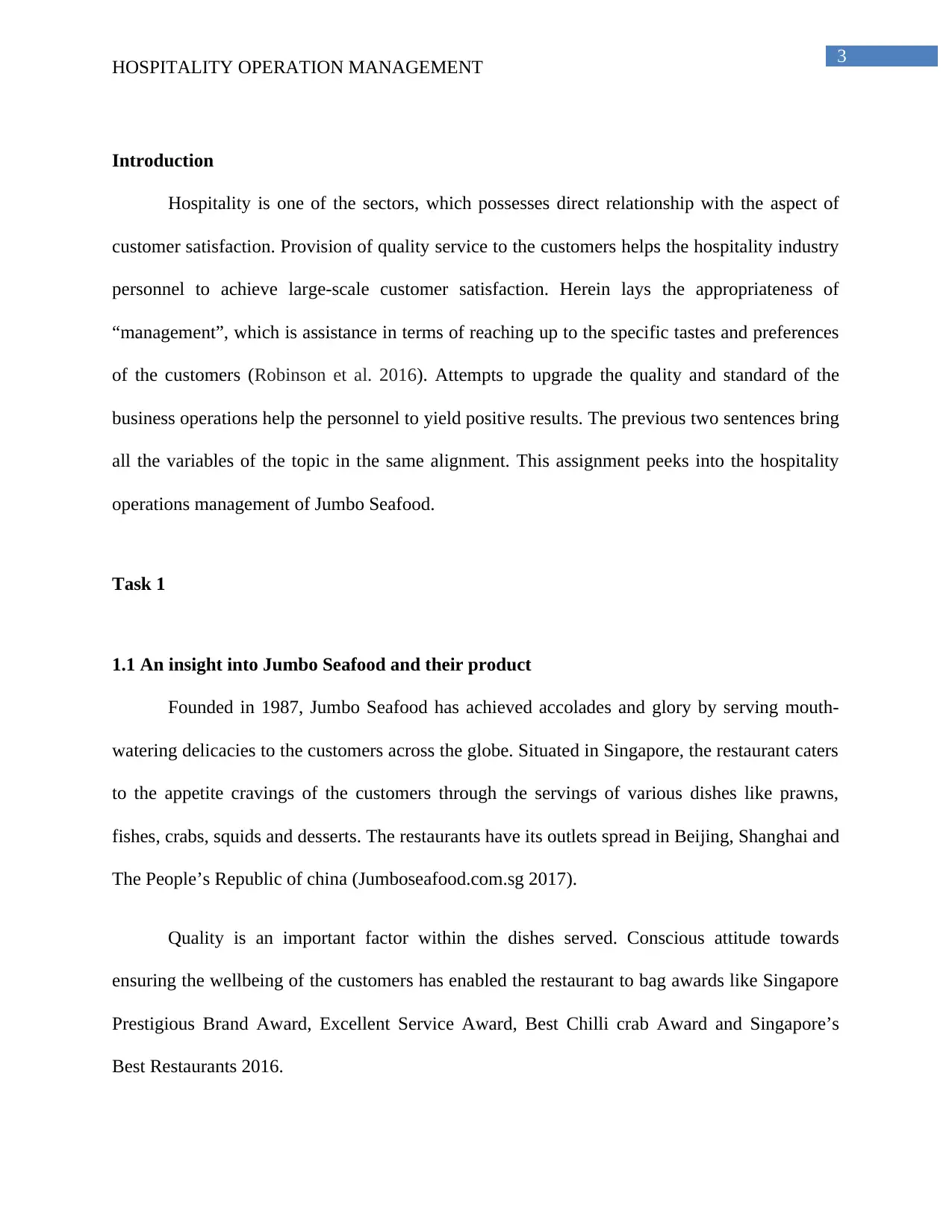
3
HOSPITALITY OPERATION MANAGEMENT
Introduction
Hospitality is one of the sectors, which possesses direct relationship with the aspect of
customer satisfaction. Provision of quality service to the customers helps the hospitality industry
personnel to achieve large-scale customer satisfaction. Herein lays the appropriateness of
“management”, which is assistance in terms of reaching up to the specific tastes and preferences
of the customers (Robinson et al. 2016). Attempts to upgrade the quality and standard of the
business operations help the personnel to yield positive results. The previous two sentences bring
all the variables of the topic in the same alignment. This assignment peeks into the hospitality
operations management of Jumbo Seafood.
Task 1
1.1 An insight into Jumbo Seafood and their product
Founded in 1987, Jumbo Seafood has achieved accolades and glory by serving mouth-
watering delicacies to the customers across the globe. Situated in Singapore, the restaurant caters
to the appetite cravings of the customers through the servings of various dishes like prawns,
fishes, crabs, squids and desserts. The restaurants have its outlets spread in Beijing, Shanghai and
The People’s Republic of china (Jumboseafood.com.sg 2017).
Quality is an important factor within the dishes served. Conscious attitude towards
ensuring the wellbeing of the customers has enabled the restaurant to bag awards like Singapore
Prestigious Brand Award, Excellent Service Award, Best Chilli crab Award and Singapore’s
Best Restaurants 2016.
HOSPITALITY OPERATION MANAGEMENT
Introduction
Hospitality is one of the sectors, which possesses direct relationship with the aspect of
customer satisfaction. Provision of quality service to the customers helps the hospitality industry
personnel to achieve large-scale customer satisfaction. Herein lays the appropriateness of
“management”, which is assistance in terms of reaching up to the specific tastes and preferences
of the customers (Robinson et al. 2016). Attempts to upgrade the quality and standard of the
business operations help the personnel to yield positive results. The previous two sentences bring
all the variables of the topic in the same alignment. This assignment peeks into the hospitality
operations management of Jumbo Seafood.
Task 1
1.1 An insight into Jumbo Seafood and their product
Founded in 1987, Jumbo Seafood has achieved accolades and glory by serving mouth-
watering delicacies to the customers across the globe. Situated in Singapore, the restaurant caters
to the appetite cravings of the customers through the servings of various dishes like prawns,
fishes, crabs, squids and desserts. The restaurants have its outlets spread in Beijing, Shanghai and
The People’s Republic of china (Jumboseafood.com.sg 2017).
Quality is an important factor within the dishes served. Conscious attitude towards
ensuring the wellbeing of the customers has enabled the restaurant to bag awards like Singapore
Prestigious Brand Award, Excellent Service Award, Best Chilli crab Award and Singapore’s
Best Restaurants 2016.
Paraphrase This Document
Need a fresh take? Get an instant paraphrase of this document with our AI Paraphraser
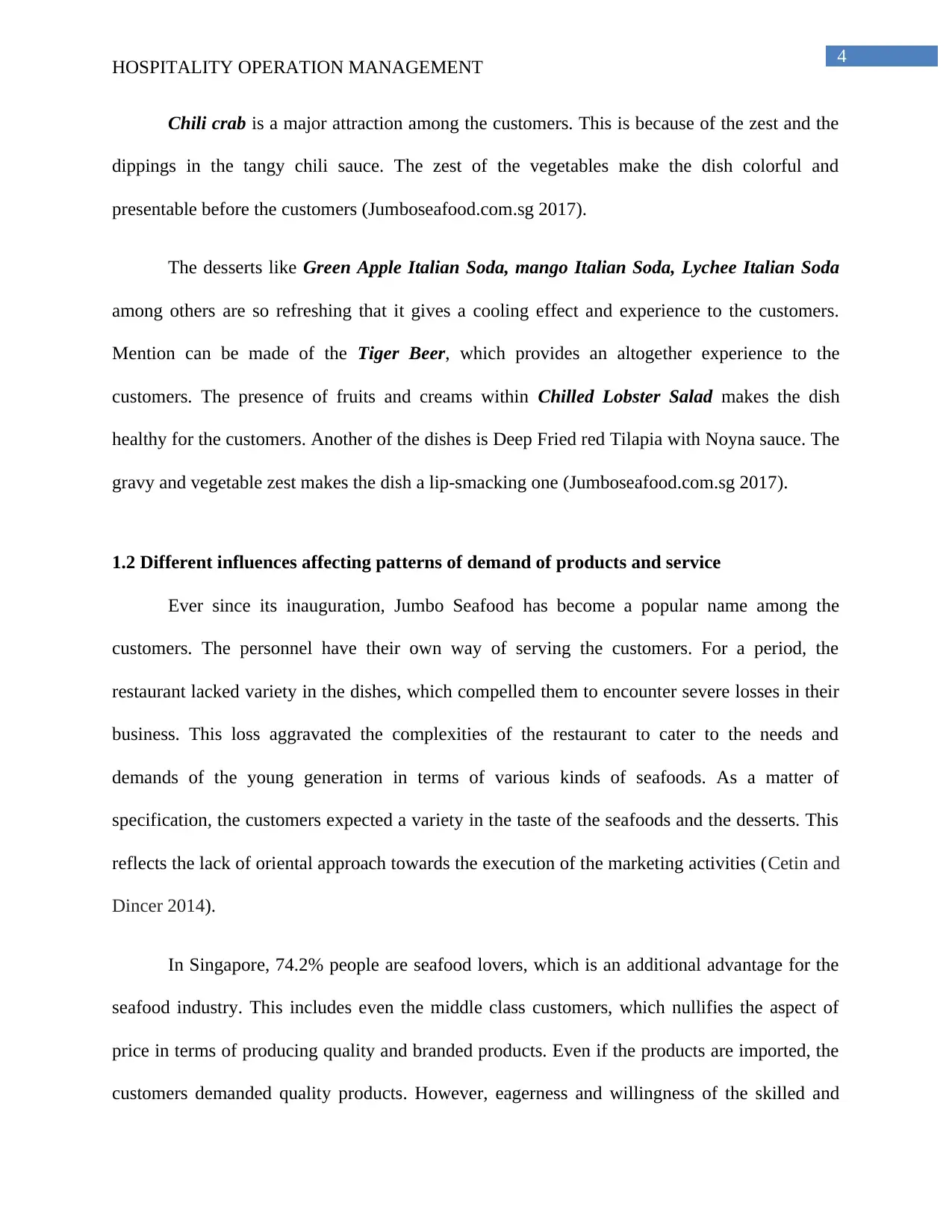
4
HOSPITALITY OPERATION MANAGEMENT
Chili crab is a major attraction among the customers. This is because of the zest and the
dippings in the tangy chili sauce. The zest of the vegetables make the dish colorful and
presentable before the customers (Jumboseafood.com.sg 2017).
The desserts like Green Apple Italian Soda, mango Italian Soda, Lychee Italian Soda
among others are so refreshing that it gives a cooling effect and experience to the customers.
Mention can be made of the Tiger Beer, which provides an altogether experience to the
customers. The presence of fruits and creams within Chilled Lobster Salad makes the dish
healthy for the customers. Another of the dishes is Deep Fried red Tilapia with Noyna sauce. The
gravy and vegetable zest makes the dish a lip-smacking one (Jumboseafood.com.sg 2017).
1.2 Different influences affecting patterns of demand of products and service
Ever since its inauguration, Jumbo Seafood has become a popular name among the
customers. The personnel have their own way of serving the customers. For a period, the
restaurant lacked variety in the dishes, which compelled them to encounter severe losses in their
business. This loss aggravated the complexities of the restaurant to cater to the needs and
demands of the young generation in terms of various kinds of seafoods. As a matter of
specification, the customers expected a variety in the taste of the seafoods and the desserts. This
reflects the lack of oriental approach towards the execution of the marketing activities (Cetin and
Dincer 2014).
In Singapore, 74.2% people are seafood lovers, which is an additional advantage for the
seafood industry. This includes even the middle class customers, which nullifies the aspect of
price in terms of producing quality and branded products. Even if the products are imported, the
customers demanded quality products. However, eagerness and willingness of the skilled and
HOSPITALITY OPERATION MANAGEMENT
Chili crab is a major attraction among the customers. This is because of the zest and the
dippings in the tangy chili sauce. The zest of the vegetables make the dish colorful and
presentable before the customers (Jumboseafood.com.sg 2017).
The desserts like Green Apple Italian Soda, mango Italian Soda, Lychee Italian Soda
among others are so refreshing that it gives a cooling effect and experience to the customers.
Mention can be made of the Tiger Beer, which provides an altogether experience to the
customers. The presence of fruits and creams within Chilled Lobster Salad makes the dish
healthy for the customers. Another of the dishes is Deep Fried red Tilapia with Noyna sauce. The
gravy and vegetable zest makes the dish a lip-smacking one (Jumboseafood.com.sg 2017).
1.2 Different influences affecting patterns of demand of products and service
Ever since its inauguration, Jumbo Seafood has become a popular name among the
customers. The personnel have their own way of serving the customers. For a period, the
restaurant lacked variety in the dishes, which compelled them to encounter severe losses in their
business. This loss aggravated the complexities of the restaurant to cater to the needs and
demands of the young generation in terms of various kinds of seafoods. As a matter of
specification, the customers expected a variety in the taste of the seafoods and the desserts. This
reflects the lack of oriental approach towards the execution of the marketing activities (Cetin and
Dincer 2014).
In Singapore, 74.2% people are seafood lovers, which is an additional advantage for the
seafood industry. This includes even the middle class customers, which nullifies the aspect of
price in terms of producing quality and branded products. Even if the products are imported, the
customers demanded quality products. However, eagerness and willingness of the skilled and
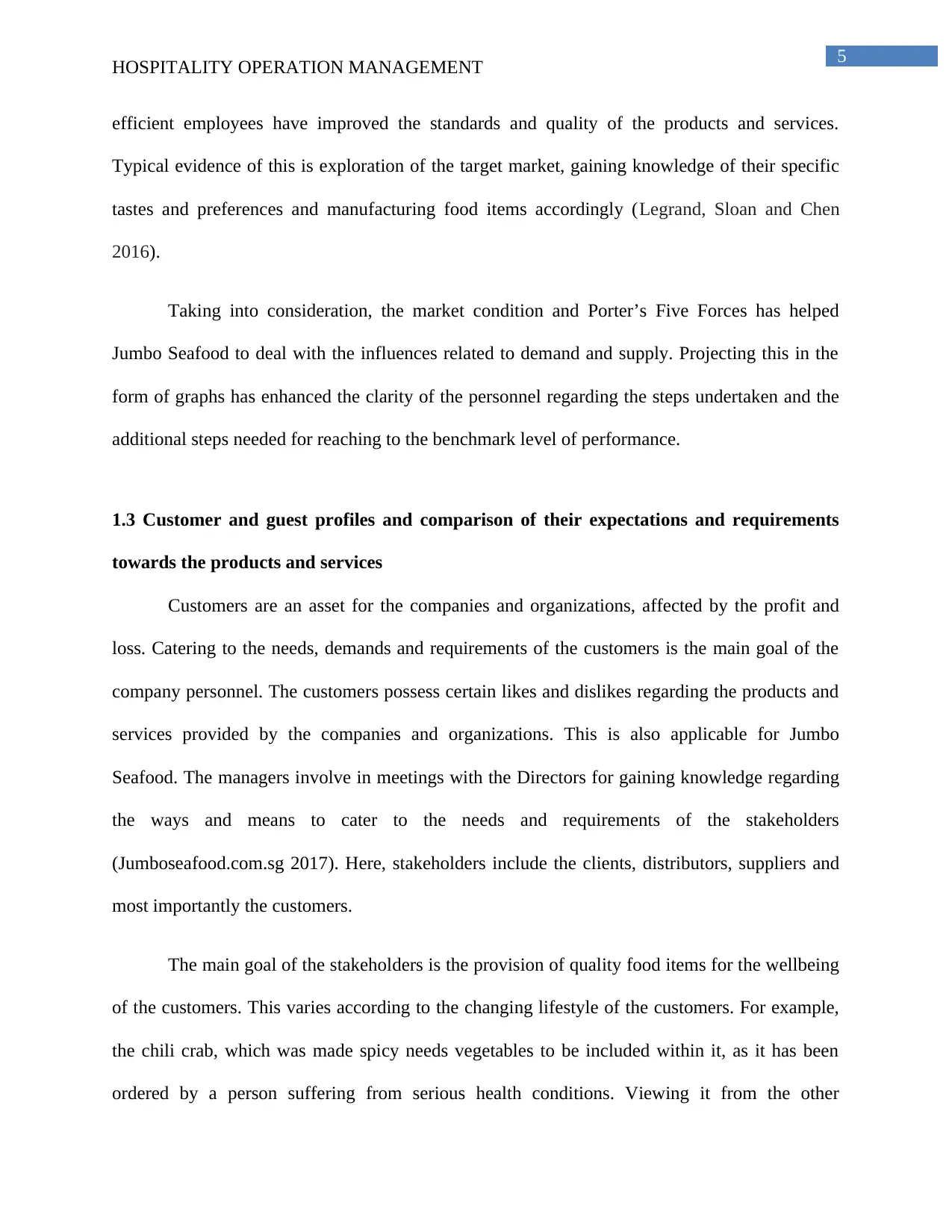
5
HOSPITALITY OPERATION MANAGEMENT
efficient employees have improved the standards and quality of the products and services.
Typical evidence of this is exploration of the target market, gaining knowledge of their specific
tastes and preferences and manufacturing food items accordingly (Legrand, Sloan and Chen
2016).
Taking into consideration, the market condition and Porter’s Five Forces has helped
Jumbo Seafood to deal with the influences related to demand and supply. Projecting this in the
form of graphs has enhanced the clarity of the personnel regarding the steps undertaken and the
additional steps needed for reaching to the benchmark level of performance.
1.3 Customer and guest profiles and comparison of their expectations and requirements
towards the products and services
Customers are an asset for the companies and organizations, affected by the profit and
loss. Catering to the needs, demands and requirements of the customers is the main goal of the
company personnel. The customers possess certain likes and dislikes regarding the products and
services provided by the companies and organizations. This is also applicable for Jumbo
Seafood. The managers involve in meetings with the Directors for gaining knowledge regarding
the ways and means to cater to the needs and requirements of the stakeholders
(Jumboseafood.com.sg 2017). Here, stakeholders include the clients, distributors, suppliers and
most importantly the customers.
The main goal of the stakeholders is the provision of quality food items for the wellbeing
of the customers. This varies according to the changing lifestyle of the customers. For example,
the chili crab, which was made spicy needs vegetables to be included within it, as it has been
ordered by a person suffering from serious health conditions. Viewing it from the other
HOSPITALITY OPERATION MANAGEMENT
efficient employees have improved the standards and quality of the products and services.
Typical evidence of this is exploration of the target market, gaining knowledge of their specific
tastes and preferences and manufacturing food items accordingly (Legrand, Sloan and Chen
2016).
Taking into consideration, the market condition and Porter’s Five Forces has helped
Jumbo Seafood to deal with the influences related to demand and supply. Projecting this in the
form of graphs has enhanced the clarity of the personnel regarding the steps undertaken and the
additional steps needed for reaching to the benchmark level of performance.
1.3 Customer and guest profiles and comparison of their expectations and requirements
towards the products and services
Customers are an asset for the companies and organizations, affected by the profit and
loss. Catering to the needs, demands and requirements of the customers is the main goal of the
company personnel. The customers possess certain likes and dislikes regarding the products and
services provided by the companies and organizations. This is also applicable for Jumbo
Seafood. The managers involve in meetings with the Directors for gaining knowledge regarding
the ways and means to cater to the needs and requirements of the stakeholders
(Jumboseafood.com.sg 2017). Here, stakeholders include the clients, distributors, suppliers and
most importantly the customers.
The main goal of the stakeholders is the provision of quality food items for the wellbeing
of the customers. This varies according to the changing lifestyle of the customers. For example,
the chili crab, which was made spicy needs vegetables to be included within it, as it has been
ordered by a person suffering from serious health conditions. Viewing it from the other
⊘ This is a preview!⊘
Do you want full access?
Subscribe today to unlock all pages.

Trusted by 1+ million students worldwide
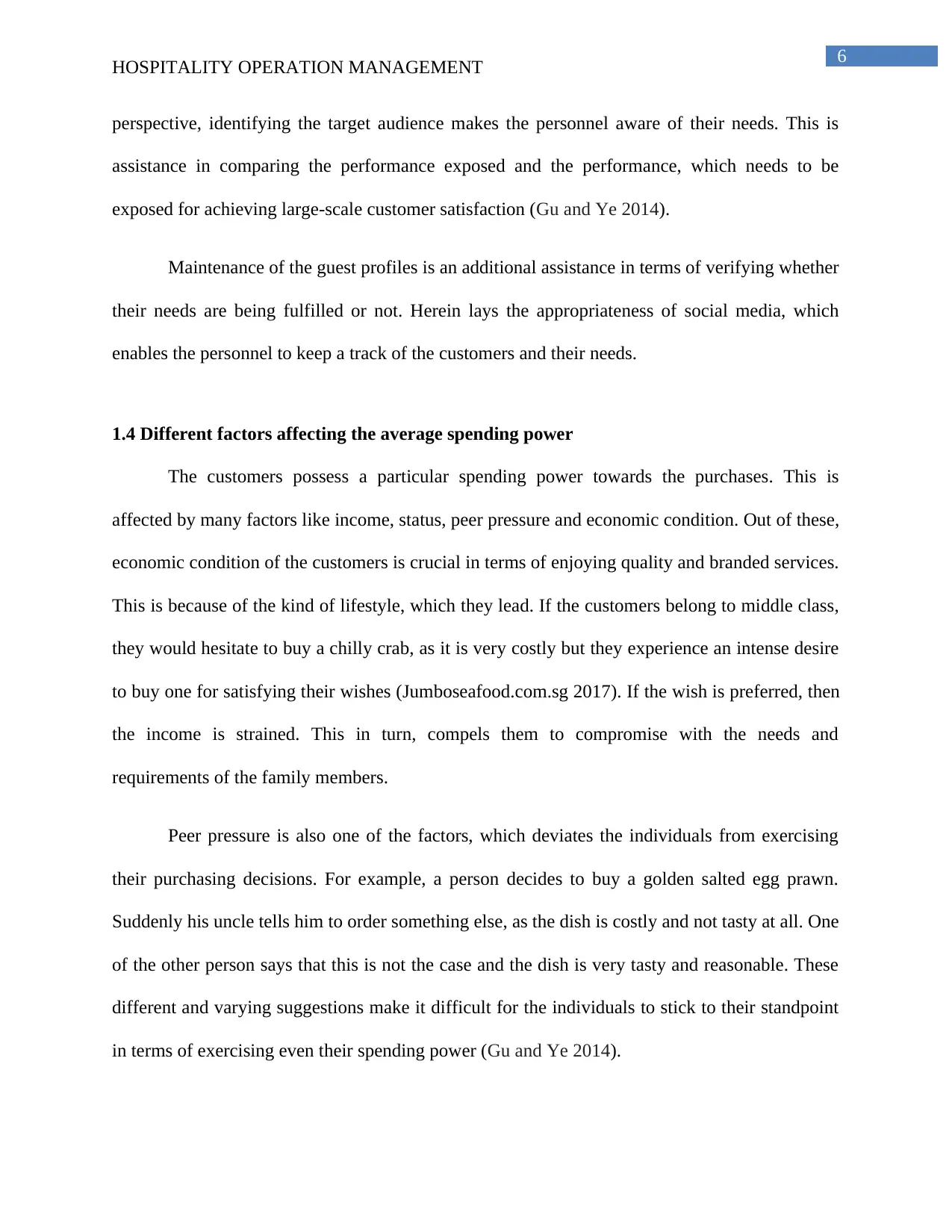
6
HOSPITALITY OPERATION MANAGEMENT
perspective, identifying the target audience makes the personnel aware of their needs. This is
assistance in comparing the performance exposed and the performance, which needs to be
exposed for achieving large-scale customer satisfaction (Gu and Ye 2014).
Maintenance of the guest profiles is an additional assistance in terms of verifying whether
their needs are being fulfilled or not. Herein lays the appropriateness of social media, which
enables the personnel to keep a track of the customers and their needs.
1.4 Different factors affecting the average spending power
The customers possess a particular spending power towards the purchases. This is
affected by many factors like income, status, peer pressure and economic condition. Out of these,
economic condition of the customers is crucial in terms of enjoying quality and branded services.
This is because of the kind of lifestyle, which they lead. If the customers belong to middle class,
they would hesitate to buy a chilly crab, as it is very costly but they experience an intense desire
to buy one for satisfying their wishes (Jumboseafood.com.sg 2017). If the wish is preferred, then
the income is strained. This in turn, compels them to compromise with the needs and
requirements of the family members.
Peer pressure is also one of the factors, which deviates the individuals from exercising
their purchasing decisions. For example, a person decides to buy a golden salted egg prawn.
Suddenly his uncle tells him to order something else, as the dish is costly and not tasty at all. One
of the other person says that this is not the case and the dish is very tasty and reasonable. These
different and varying suggestions make it difficult for the individuals to stick to their standpoint
in terms of exercising even their spending power (Gu and Ye 2014).
HOSPITALITY OPERATION MANAGEMENT
perspective, identifying the target audience makes the personnel aware of their needs. This is
assistance in comparing the performance exposed and the performance, which needs to be
exposed for achieving large-scale customer satisfaction (Gu and Ye 2014).
Maintenance of the guest profiles is an additional assistance in terms of verifying whether
their needs are being fulfilled or not. Herein lays the appropriateness of social media, which
enables the personnel to keep a track of the customers and their needs.
1.4 Different factors affecting the average spending power
The customers possess a particular spending power towards the purchases. This is
affected by many factors like income, status, peer pressure and economic condition. Out of these,
economic condition of the customers is crucial in terms of enjoying quality and branded services.
This is because of the kind of lifestyle, which they lead. If the customers belong to middle class,
they would hesitate to buy a chilly crab, as it is very costly but they experience an intense desire
to buy one for satisfying their wishes (Jumboseafood.com.sg 2017). If the wish is preferred, then
the income is strained. This in turn, compels them to compromise with the needs and
requirements of the family members.
Peer pressure is also one of the factors, which deviates the individuals from exercising
their purchasing decisions. For example, a person decides to buy a golden salted egg prawn.
Suddenly his uncle tells him to order something else, as the dish is costly and not tasty at all. One
of the other person says that this is not the case and the dish is very tasty and reasonable. These
different and varying suggestions make it difficult for the individuals to stick to their standpoint
in terms of exercising even their spending power (Gu and Ye 2014).
Paraphrase This Document
Need a fresh take? Get an instant paraphrase of this document with our AI Paraphraser
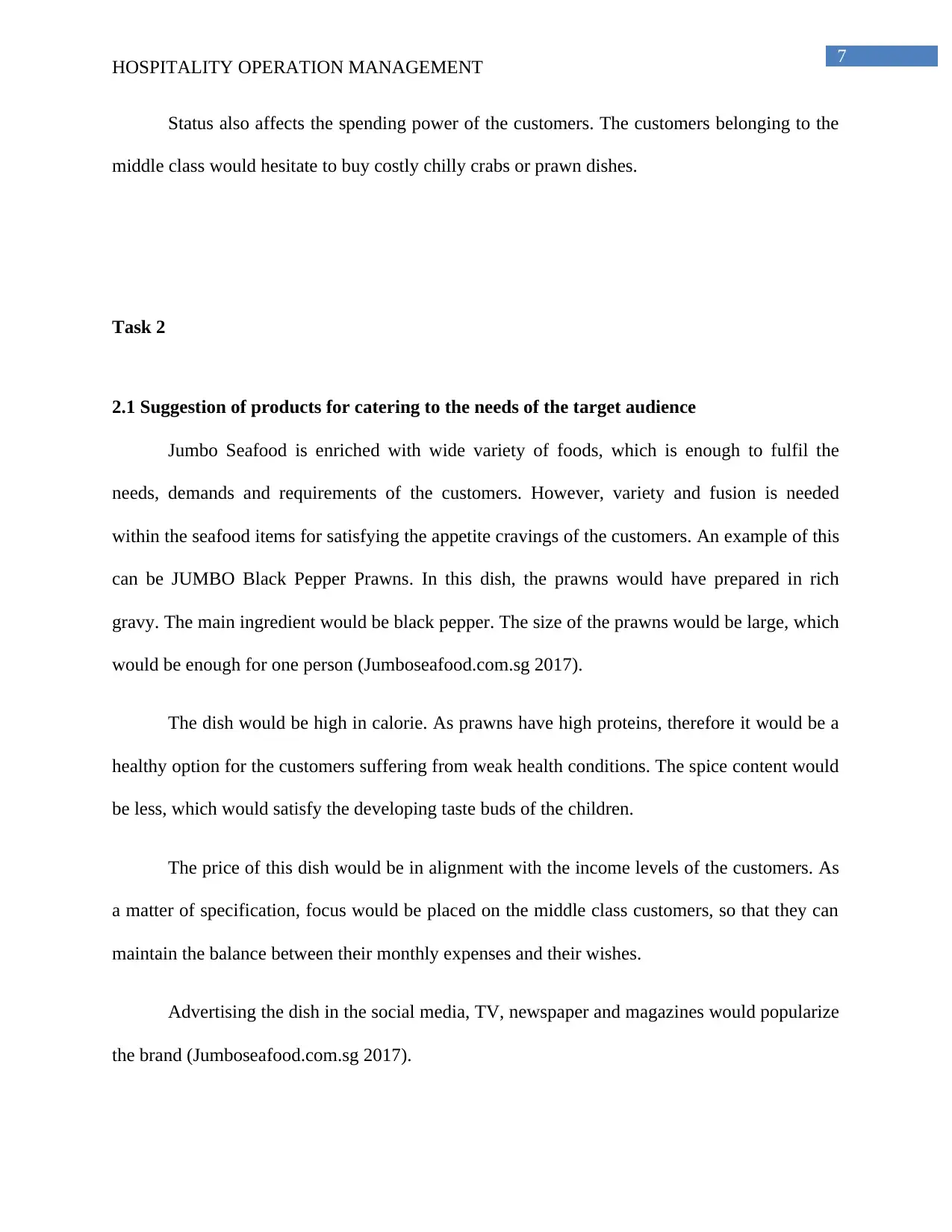
7
HOSPITALITY OPERATION MANAGEMENT
Status also affects the spending power of the customers. The customers belonging to the
middle class would hesitate to buy costly chilly crabs or prawn dishes.
Task 2
2.1 Suggestion of products for catering to the needs of the target audience
Jumbo Seafood is enriched with wide variety of foods, which is enough to fulfil the
needs, demands and requirements of the customers. However, variety and fusion is needed
within the seafood items for satisfying the appetite cravings of the customers. An example of this
can be JUMBO Black Pepper Prawns. In this dish, the prawns would have prepared in rich
gravy. The main ingredient would be black pepper. The size of the prawns would be large, which
would be enough for one person (Jumboseafood.com.sg 2017).
The dish would be high in calorie. As prawns have high proteins, therefore it would be a
healthy option for the customers suffering from weak health conditions. The spice content would
be less, which would satisfy the developing taste buds of the children.
The price of this dish would be in alignment with the income levels of the customers. As
a matter of specification, focus would be placed on the middle class customers, so that they can
maintain the balance between their monthly expenses and their wishes.
Advertising the dish in the social media, TV, newspaper and magazines would popularize
the brand (Jumboseafood.com.sg 2017).
HOSPITALITY OPERATION MANAGEMENT
Status also affects the spending power of the customers. The customers belonging to the
middle class would hesitate to buy costly chilly crabs or prawn dishes.
Task 2
2.1 Suggestion of products for catering to the needs of the target audience
Jumbo Seafood is enriched with wide variety of foods, which is enough to fulfil the
needs, demands and requirements of the customers. However, variety and fusion is needed
within the seafood items for satisfying the appetite cravings of the customers. An example of this
can be JUMBO Black Pepper Prawns. In this dish, the prawns would have prepared in rich
gravy. The main ingredient would be black pepper. The size of the prawns would be large, which
would be enough for one person (Jumboseafood.com.sg 2017).
The dish would be high in calorie. As prawns have high proteins, therefore it would be a
healthy option for the customers suffering from weak health conditions. The spice content would
be less, which would satisfy the developing taste buds of the children.
The price of this dish would be in alignment with the income levels of the customers. As
a matter of specification, focus would be placed on the middle class customers, so that they can
maintain the balance between their monthly expenses and their wishes.
Advertising the dish in the social media, TV, newspaper and magazines would popularize
the brand (Jumboseafood.com.sg 2017).
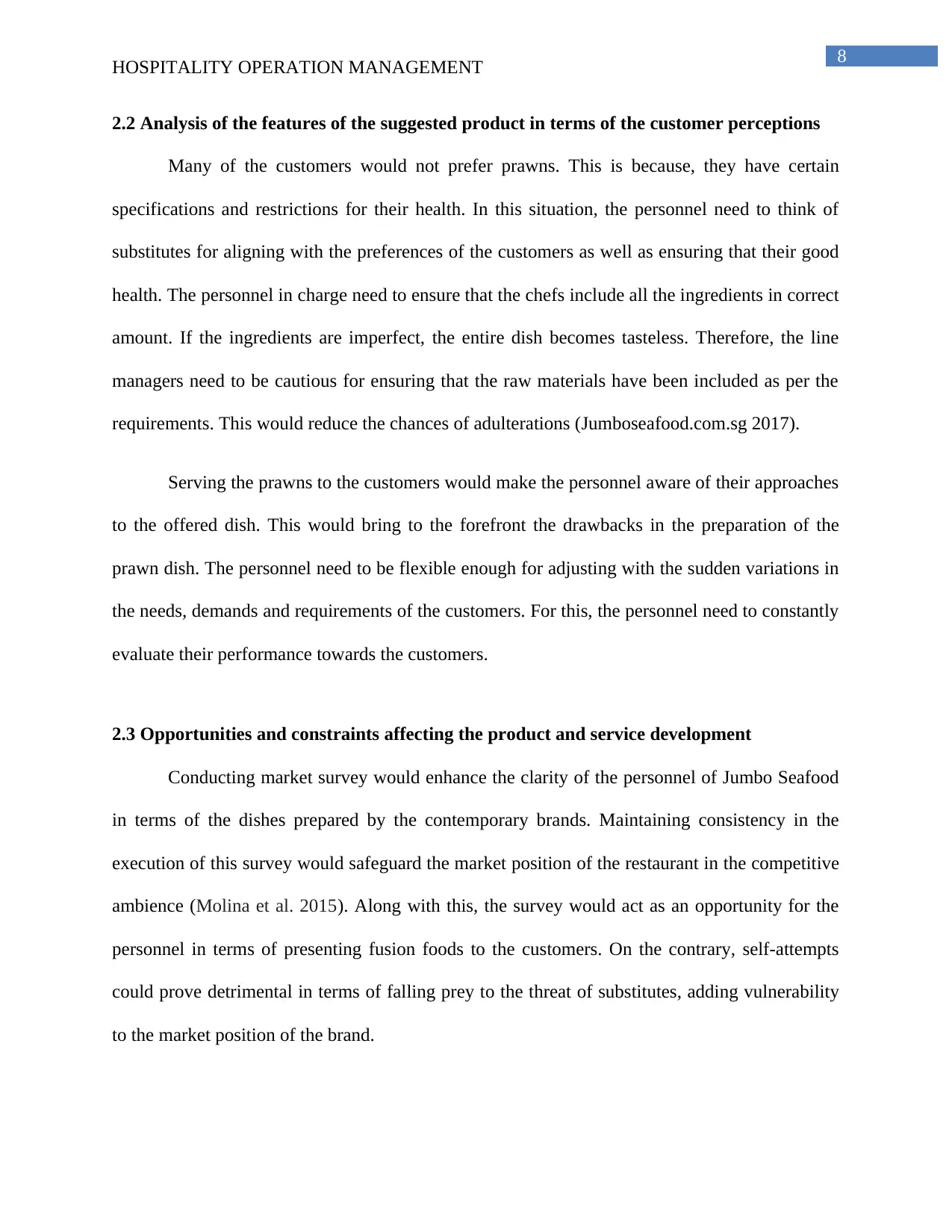
8
HOSPITALITY OPERATION MANAGEMENT
2.2 Analysis of the features of the suggested product in terms of the customer perceptions
Many of the customers would not prefer prawns. This is because, they have certain
specifications and restrictions for their health. In this situation, the personnel need to think of
substitutes for aligning with the preferences of the customers as well as ensuring that their good
health. The personnel in charge need to ensure that the chefs include all the ingredients in correct
amount. If the ingredients are imperfect, the entire dish becomes tasteless. Therefore, the line
managers need to be cautious for ensuring that the raw materials have been included as per the
requirements. This would reduce the chances of adulterations (Jumboseafood.com.sg 2017).
Serving the prawns to the customers would make the personnel aware of their approaches
to the offered dish. This would bring to the forefront the drawbacks in the preparation of the
prawn dish. The personnel need to be flexible enough for adjusting with the sudden variations in
the needs, demands and requirements of the customers. For this, the personnel need to constantly
evaluate their performance towards the customers.
2.3 Opportunities and constraints affecting the product and service development
Conducting market survey would enhance the clarity of the personnel of Jumbo Seafood
in terms of the dishes prepared by the contemporary brands. Maintaining consistency in the
execution of this survey would safeguard the market position of the restaurant in the competitive
ambience (Molina et al. 2015). Along with this, the survey would act as an opportunity for the
personnel in terms of presenting fusion foods to the customers. On the contrary, self-attempts
could prove detrimental in terms of falling prey to the threat of substitutes, adding vulnerability
to the market position of the brand.
HOSPITALITY OPERATION MANAGEMENT
2.2 Analysis of the features of the suggested product in terms of the customer perceptions
Many of the customers would not prefer prawns. This is because, they have certain
specifications and restrictions for their health. In this situation, the personnel need to think of
substitutes for aligning with the preferences of the customers as well as ensuring that their good
health. The personnel in charge need to ensure that the chefs include all the ingredients in correct
amount. If the ingredients are imperfect, the entire dish becomes tasteless. Therefore, the line
managers need to be cautious for ensuring that the raw materials have been included as per the
requirements. This would reduce the chances of adulterations (Jumboseafood.com.sg 2017).
Serving the prawns to the customers would make the personnel aware of their approaches
to the offered dish. This would bring to the forefront the drawbacks in the preparation of the
prawn dish. The personnel need to be flexible enough for adjusting with the sudden variations in
the needs, demands and requirements of the customers. For this, the personnel need to constantly
evaluate their performance towards the customers.
2.3 Opportunities and constraints affecting the product and service development
Conducting market survey would enhance the clarity of the personnel of Jumbo Seafood
in terms of the dishes prepared by the contemporary brands. Maintaining consistency in the
execution of this survey would safeguard the market position of the restaurant in the competitive
ambience (Molina et al. 2015). Along with this, the survey would act as an opportunity for the
personnel in terms of presenting fusion foods to the customers. On the contrary, self-attempts
could prove detrimental in terms of falling prey to the threat of substitutes, adding vulnerability
to the market position of the brand.
⊘ This is a preview!⊘
Do you want full access?
Subscribe today to unlock all pages.

Trusted by 1+ million students worldwide
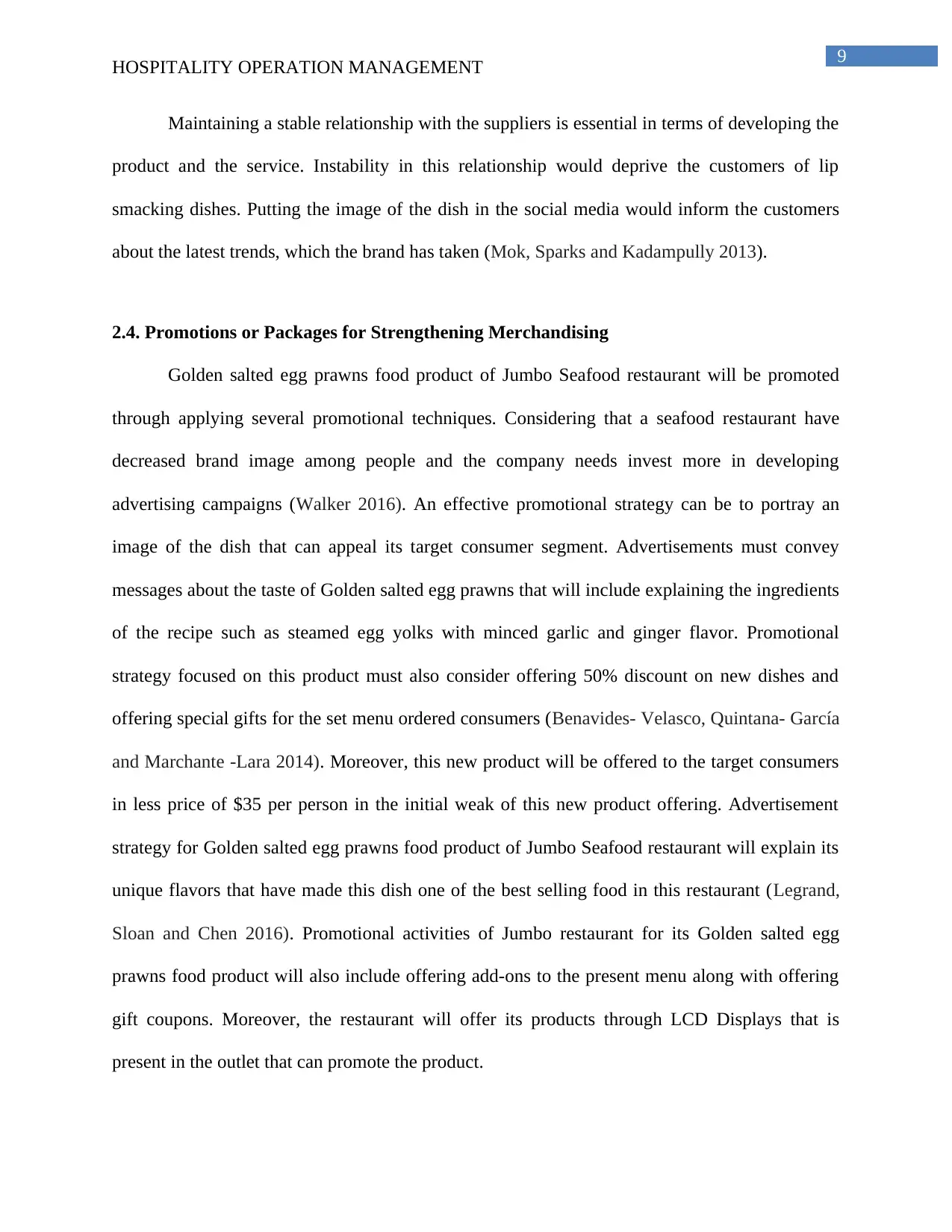
9
HOSPITALITY OPERATION MANAGEMENT
Maintaining a stable relationship with the suppliers is essential in terms of developing the
product and the service. Instability in this relationship would deprive the customers of lip
smacking dishes. Putting the image of the dish in the social media would inform the customers
about the latest trends, which the brand has taken (Mok, Sparks and Kadampully 2013).
2.4. Promotions or Packages for Strengthening Merchandising
Golden salted egg prawns food product of Jumbo Seafood restaurant will be promoted
through applying several promotional techniques. Considering that a seafood restaurant have
decreased brand image among people and the company needs invest more in developing
advertising campaigns (Walker 2016). An effective promotional strategy can be to portray an
image of the dish that can appeal its target consumer segment. Advertisements must convey
messages about the taste of Golden salted egg prawns that will include explaining the ingredients
of the recipe such as steamed egg yolks with minced garlic and ginger flavor. Promotional
strategy focused on this product must also consider offering 50% discount on new dishes and
offering special gifts for the set menu ordered consumers (Benavides- Velasco, Quintana- García
and Marchante -Lara 2014). Moreover, this new product will be offered to the target consumers
in less price of $35 per person in the initial weak of this new product offering. Advertisement
strategy for Golden salted egg prawns food product of Jumbo Seafood restaurant will explain its
unique flavors that have made this dish one of the best selling food in this restaurant (Legrand,
Sloan and Chen 2016). Promotional activities of Jumbo restaurant for its Golden salted egg
prawns food product will also include offering add-ons to the present menu along with offering
gift coupons. Moreover, the restaurant will offer its products through LCD Displays that is
present in the outlet that can promote the product.
HOSPITALITY OPERATION MANAGEMENT
Maintaining a stable relationship with the suppliers is essential in terms of developing the
product and the service. Instability in this relationship would deprive the customers of lip
smacking dishes. Putting the image of the dish in the social media would inform the customers
about the latest trends, which the brand has taken (Mok, Sparks and Kadampully 2013).
2.4. Promotions or Packages for Strengthening Merchandising
Golden salted egg prawns food product of Jumbo Seafood restaurant will be promoted
through applying several promotional techniques. Considering that a seafood restaurant have
decreased brand image among people and the company needs invest more in developing
advertising campaigns (Walker 2016). An effective promotional strategy can be to portray an
image of the dish that can appeal its target consumer segment. Advertisements must convey
messages about the taste of Golden salted egg prawns that will include explaining the ingredients
of the recipe such as steamed egg yolks with minced garlic and ginger flavor. Promotional
strategy focused on this product must also consider offering 50% discount on new dishes and
offering special gifts for the set menu ordered consumers (Benavides- Velasco, Quintana- García
and Marchante -Lara 2014). Moreover, this new product will be offered to the target consumers
in less price of $35 per person in the initial weak of this new product offering. Advertisement
strategy for Golden salted egg prawns food product of Jumbo Seafood restaurant will explain its
unique flavors that have made this dish one of the best selling food in this restaurant (Legrand,
Sloan and Chen 2016). Promotional activities of Jumbo restaurant for its Golden salted egg
prawns food product will also include offering add-ons to the present menu along with offering
gift coupons. Moreover, the restaurant will offer its products through LCD Displays that is
present in the outlet that can promote the product.
Paraphrase This Document
Need a fresh take? Get an instant paraphrase of this document with our AI Paraphraser

10
HOSPITALITY OPERATION MANAGEMENT
HOSPITALITY OPERATION MANAGEMENT
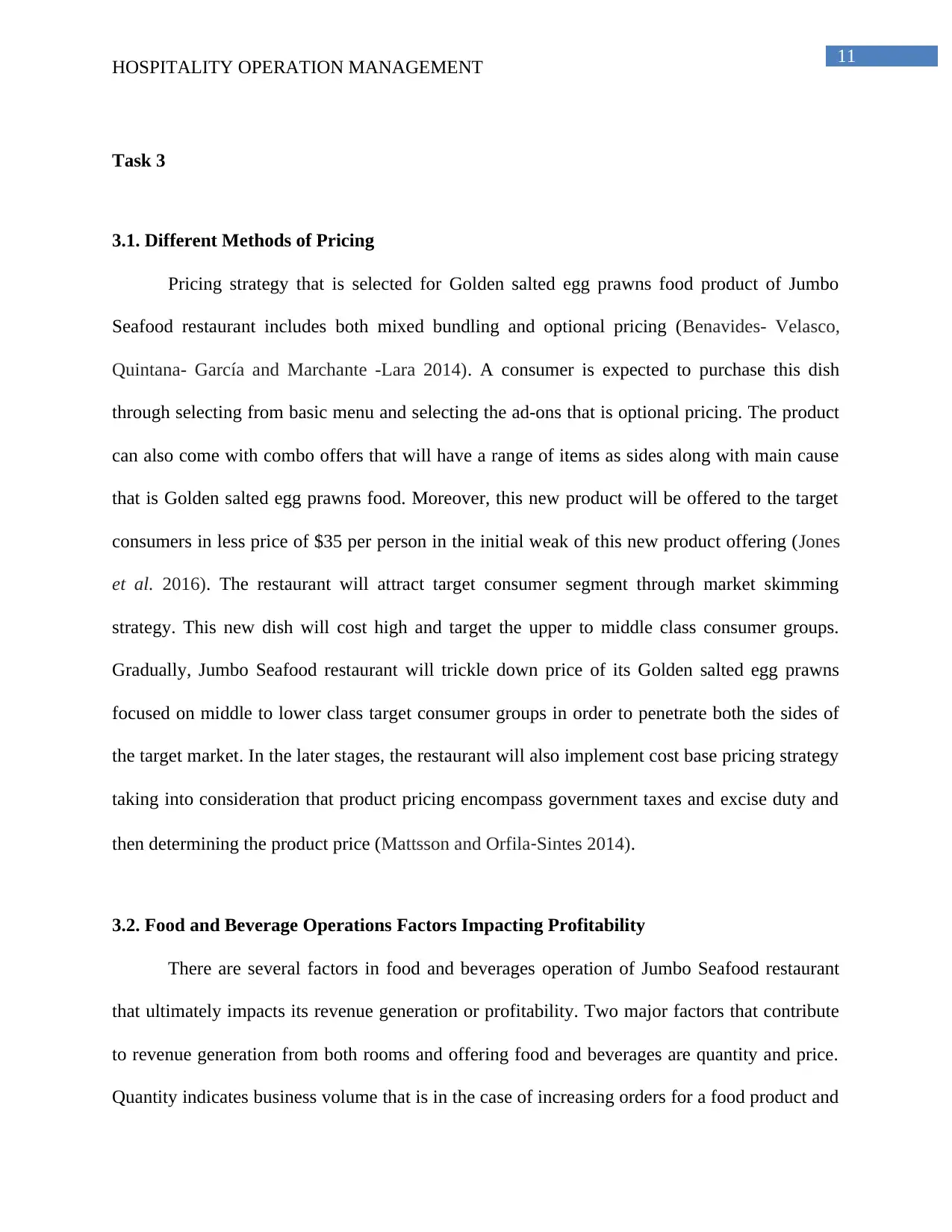
11
HOSPITALITY OPERATION MANAGEMENT
Task 3
3.1. Different Methods of Pricing
Pricing strategy that is selected for Golden salted egg prawns food product of Jumbo
Seafood restaurant includes both mixed bundling and optional pricing (Benavides- Velasco,
Quintana- García and Marchante -Lara 2014). A consumer is expected to purchase this dish
through selecting from basic menu and selecting the ad-ons that is optional pricing. The product
can also come with combo offers that will have a range of items as sides along with main cause
that is Golden salted egg prawns food. Moreover, this new product will be offered to the target
consumers in less price of $35 per person in the initial weak of this new product offering (Jones
et al. 2016). The restaurant will attract target consumer segment through market skimming
strategy. This new dish will cost high and target the upper to middle class consumer groups.
Gradually, Jumbo Seafood restaurant will trickle down price of its Golden salted egg prawns
focused on middle to lower class target consumer groups in order to penetrate both the sides of
the target market. In the later stages, the restaurant will also implement cost base pricing strategy
taking into consideration that product pricing encompass government taxes and excise duty and
then determining the product price (Mattsson and Orfila‐Sintes 2014).
3.2. Food and Beverage Operations Factors Impacting Profitability
There are several factors in food and beverages operation of Jumbo Seafood restaurant
that ultimately impacts its revenue generation or profitability. Two major factors that contribute
to revenue generation from both rooms and offering food and beverages are quantity and price.
Quantity indicates business volume that is in the case of increasing orders for a food product and
HOSPITALITY OPERATION MANAGEMENT
Task 3
3.1. Different Methods of Pricing
Pricing strategy that is selected for Golden salted egg prawns food product of Jumbo
Seafood restaurant includes both mixed bundling and optional pricing (Benavides- Velasco,
Quintana- García and Marchante -Lara 2014). A consumer is expected to purchase this dish
through selecting from basic menu and selecting the ad-ons that is optional pricing. The product
can also come with combo offers that will have a range of items as sides along with main cause
that is Golden salted egg prawns food. Moreover, this new product will be offered to the target
consumers in less price of $35 per person in the initial weak of this new product offering (Jones
et al. 2016). The restaurant will attract target consumer segment through market skimming
strategy. This new dish will cost high and target the upper to middle class consumer groups.
Gradually, Jumbo Seafood restaurant will trickle down price of its Golden salted egg prawns
focused on middle to lower class target consumer groups in order to penetrate both the sides of
the target market. In the later stages, the restaurant will also implement cost base pricing strategy
taking into consideration that product pricing encompass government taxes and excise duty and
then determining the product price (Mattsson and Orfila‐Sintes 2014).
3.2. Food and Beverage Operations Factors Impacting Profitability
There are several factors in food and beverages operation of Jumbo Seafood restaurant
that ultimately impacts its revenue generation or profitability. Two major factors that contribute
to revenue generation from both rooms and offering food and beverages are quantity and price.
Quantity indicates business volume that is in the case of increasing orders for a food product and
⊘ This is a preview!⊘
Do you want full access?
Subscribe today to unlock all pages.

Trusted by 1+ million students worldwide
1 out of 20
Related Documents
Your All-in-One AI-Powered Toolkit for Academic Success.
+13062052269
info@desklib.com
Available 24*7 on WhatsApp / Email
![[object Object]](/_next/static/media/star-bottom.7253800d.svg)
Unlock your academic potential
Copyright © 2020–2025 A2Z Services. All Rights Reserved. Developed and managed by ZUCOL.




